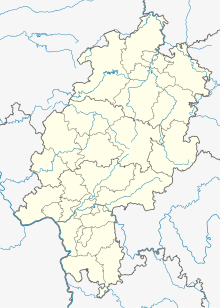Münchhausen (desert)
Münchhausen is an abandoned settlement west of the city center of Stadtallendorf in the central Hessian district of Marburg-Biedenkopf . It was located between today's Plausdorfer Weg and the B 454 . Today reminiscent Flurnamen Munchausen and Georgenhof and the nearby Münch-mill of the former settlement. Also that a little southeast. The Münchmühle subcamp located in the area was named after the desert area / mill.
history
The place was first mentioned around 1248; it belonged to the Counts of Ziegenhain , although other secular and spiritual lords had property or income there. So are z. B. The tithe income of the Archbishopric of Mainz around 1248, as well as the tithe income of the Lords of Eppstein in the period from 1250/60 and 1282/83, which were at least temporarily pledged to the Mainz mayor in Amöneburg . In 1274, Count Ludwig II of Ziegenhain zu Nidda sold the village ( villa ) with its own people, jurisdiction and all rights to the Teutonic Order in Marburg . The place was parish from the parish of (city) Allendorf. The order increased its property in the place in the following period through further donations and purchases. As early as 1275, the widow of Count Gottfried V. von Ziegenhain (Ludwig II's cousin), Hedwig von Castell , gave her right to two servants to the order, in 1295 he acquired the income of the clergyman Friedrich Raustein in Münchhausen, and further goods were acquired by the order in 1323 occupied. In 1358 the Teutonic Order had two large farms in Münchhausen, with a total of 87½ acres of arable land and 4 acres of meadows.
As a result, the majority of the place seems to have come into the possession of the Archbishopric of Mainz : In 1364 it was transferred from the Archbishopric to the Milchling family . However, there were still other owners in the village; In 1304 the Riedesel sold their goods in Münchhausen to the St. Georg monastery in Homberg (Efze) , and the monastery still owned the former settlement, which had fallen desolate by 1486 at the latest, until at least the end of the 15th century. In 1486 a certain Gerlach von Dautphe sold to the Upper Hessian court master Hans von Dörnberg (1427–1506) an estate in the desert area of Münchhausen, which he had exchanged for the St. Georg monastery, and in 1493 Hans von Dörnberg acquired a meadow from the monastery.
In 1586 there was again a small farmstead on the desert, which was then destroyed in the Thirty Years War . In 1672 the community of Allendorf bought the desert and built a mill, the Münch mill, on Netz-Graben, not far northeast of the former settlement.
In the terrain, which slopes slightly to the north, traces of a circular moat can still be found today, which probably once surrounded a fortified courtyard. There are no remains of a possible castle complex as such.
literature
- Rudolf Knappe: Medieval castles in Hessen. 800 castles, castle ruins and fortifications. 2nd Edition. Wartberg-Verlag, Gudensberg-Gleichen 1995, ISBN 3-86134-228-6 .
Web links
- Münchhausen (desert), Marburg-Biedenkopf district. Historical local dictionary for Hessen. (As of February 17, 2014). In: Landesgeschichtliches Informationssystem Hessen (LAGIS).
Coordinates: 50 ° 49 ′ 21.7 " N , 8 ° 59 ′ 11.4" E
